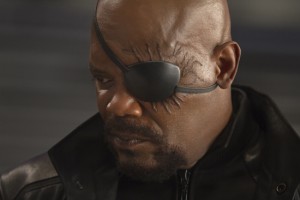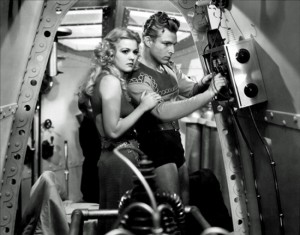Why Hollywood Loves Comic Books
And why some critics can’t stand them
/https://tf-cmsv2-smithsonianmag-media.s3.amazonaws.com/filer/Avengers_header.jpg)
The highest-grossing film of all time, Avatar, has started to make its way through the cable television universe. I saw a few minutes of it this week on FX, and was surprised by how different the film seemed than when I saw it in a theater. On TV it looked smaller, less distinctive, more ordinary, harder to tell apart from the sci-fi films and shows surrounding it. Avatar is a movie you can only truly appreciate in a theater setting—something director James Cameron understands as well as anyone in the business. He makes movies for theaters, not homes.
Although the box office is trending higher in recent months, National Association of Theatre Owners records indicate that movie attendance is at a 20-year low. Receipts have fallen a half-billion dollars. Facing a growing number of rival entertainments, the film industry needs to find a way to bring viewers back to theaters.
Hollywood faced these problems before, with the spread of radio in the late 1920s, and the rise of television some 30 years later. To fight TV, the industry turned to widescreen processes, more color (as opposed to B&W), the first sustained attempts at 3D, and a plague of religious epics that descended on theaters in the 1950s.
More recently, filmmakers have been resorting to similar tactics to differentiate the movie-going experience from TV, YouTube, and games: bigger budgets, louder soundtracks, 3D, and stories whose visual scope can’t be contained on iPads and other handheld devices. Weirdly, these tactics happen to converge with movies derived from comic books.
The industry has always relied on comics and cartoons for inspiration. In a sense movies and comics grew up together, and each helped the other to thrive. The Edison Manufacturing Co. released The Whole Dam Family and the Dam Dog in 1905, capitalizing on a popular series of lithographs. A year later Edison put out Dream of a Rarebit Fiend, based on Winsor McCay’s comic strip. McCay animated another of his strips for what is now known as Little Nemo (1911). (The film was actually released as Winsor McCay, the Famous Cartoonist of the N.Y. Herald and His Moving Comics.)
McCay did more than anyone to turn both comic strips and screen animation into art forms. He helped free artists from a visual style based on stage performances, with action occurring on a flat plane behind a proscenium. McCay opened up a world with depth, with shifting horizons, and his influence can still be seen today in cross-cutting techniques and in the angled compositions found in X-Men or Transformers.
In following years stories moved from comics to film and back again. Blondie, Dennis the Menace, The Addams Family, Jungle Jim, Li’l Abner, Popeye, Dick Tracy, and many others worked in both comics and movies. A star of radio and screen, Gene Autry had his own comic book as well. (So did his rival Roy Rogers.) Universal made so much money from a serial derived from the comic strip Tailspin Tommy that it made a deal with King Features Syndicate to develop other comic-strip-based movies. Flash Gordon, Buck Rogers, and Secret Agent X-9 (written by Dashiell Hammett) followed quickly. Based on Alex Raymond’s comic strip, Flash Gordon was so popular that theater owners showed episodes at night on top of matinee screenings for kids. (The serial was later re-edited into a feature version.)
Before he was impersonated by Christian Bale, George Clooney, and Michael Keaton, even before he had his own television series, Batman starred in a 1943 Columbia Pictures serial. Superman started out in a cartoon series for Paramount before starring in a TV series and then making the jump to features in the 1970s and again in 2006′s Superman Returns. Both superheroes are part of the DC Comics stable, now owned by Warner Bros. (The latest Batman movie, The Dark Knight Rises, will be released on July 20.)
DC rival Marvel Comics approached film warily at first. Republic Pictures produced a serial of Captain America in 1944, and Cannon Pictures released a ludicrous, low-budget Captain America in 1990. But it wasn’t until recently that Marvel Studios began aggressively developing its characters—including Spider-Man, X-Men, The Fantastic Four, Iron Man, Thor, and The Avengers. (Starring Andrew Garfield and Emma Stone, The Amazing Spider-Man will open on July 3.)
Despite works from filmmakers as renowned as Steven Spielberg (The Adventures of Tin-Tin) and Martin Scorsese (Hugo, based on Brian Selznick’s illustrated novel The Invention of Hugo Cabret), some critics worry that comic book adaptations are destroying cinema as an art form. Reviewing Green Lantern, New Yorker critic David Denby asked, “Do these movies really satisfy anyone except kids and overgrown boys?”
Or take today’s lukewarm review of The Avengers by New York Times critic A.O. Scott, who called the film “a giant A.T.M. for Marvel and its new studio overlords, the Walt Disney Company.” When he isn’t giving away the film’s best jokes, or identifying with The Hulk, Scott is busy lambasting “the grinding, hectic emptiness, the bloated cynicism that is less a shortcoming of this particular film than a feature of the genre.”
I attended the same screening Scott did, and felt that the audience was much more enthusiastic about the film. Yes, it’s big, and so loud that its explosions were positively percussive. But I also found it nimble, clever, funny, and fast—equivalent to any action film of the year so far. Scott arrived late and had to sit in the front rows and to the side of the screen, which may have colored his experience. (Joe Morgenstern of The Wall Street Journal sat through the first half-hour of the film with defective 3D glasses, but at least he acknowledged that in his review: “The technical screw-up was so upsetting that it may have skewed my judgment about the movie as a whole.”)

Nick Fury (Samuel L. Jackson) Photo: Zade Rosenthal © 2011 MVLFFLLC. TM & © 2011 Marvel. All Rights Reserved.
The Times critic has never been a fan of action blockbusters, so it shouldn’t be much of a surprise when he refers huffily to “overblown, skull-assaulting action sequences”—the precise reason why many viewers love the comic books. What has raised eyebrows is the reaction on Twitter by Samuel J. Jackson (S.H.I.E.L.D. director Nick Fury in the film), who fumed that “Scott needs new job!”
Predictably, several critics defended Scott, if not his opinions. But I’m on Jackson’s side here. If you need to cite a 1959 Howard Hawks film, the Rat Pack, and an irrelevant TV role from the 1960s, you have placed yourself pretty definitively outside the demographic The Avengers is targeting. And if the best you can say about the comic book genre is that it’s “entered a phase of imaginative decadence,” you can just ignore all the elements that make The Avengers so enjoyable.
Read new Reel Culture postings every Wednesday and Friday. And you can follow me on Twitter @Film_Legacy.
/https://tf-cmsv2-smithsonianmag-media.s3.amazonaws.com/accounts/headshot/daniel-eagan-240.jpg)

/https://tf-cmsv2-smithsonianmag-media.s3.amazonaws.com/accounts/headshot/daniel-eagan-240.jpg)